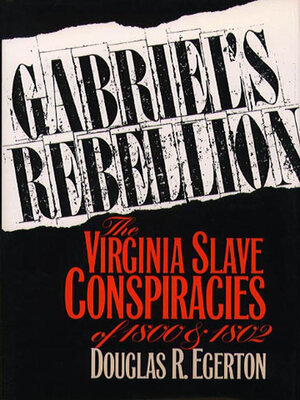
Sign up to save your library
With an OverDrive account, you can save your favorite libraries for at-a-glance information about availability. Find out more about OverDrive accounts.
Find this title in Libby, the library reading app by OverDrive.



Search for a digital library with this title
Title found at these libraries:
| Library Name | Distance |
|---|---|
| Loading... |
Gabriel’s Rebellion tells the dramatic story of what was perhaps the most extensive slave conspiracy in the history of the American South. Douglas Egerton illuminates the complex motivations that underlay two related Virginia slave revolts: the first, in 1800, led by the slave known as Gabriel; and the second, called the 'Easter Plot,' instigated in 1802 by one of his followers. Although Gabriel has frequently been portrayed as a messianic, Samson-like figure, Egerton shows that he was a literate and highly skilled blacksmith whose primary goal was to destroy the economic hegemony of the 'merchants,' the only whites he ever identified as his enemies. According to Egerton, the social, political, and economic disorder of the Revolutionary era weakened some of the harsh controls that held slavery in place during colonial times. Emboldened by these conditions, a small number of literate slaves — most of them highly skilled artisans — planned an armed insurrection aimed at destroying slavery in Virginia. The intricate scheme failed, as did the Easter Plot that stemmed from it, and Gabriel and many of his followers were hanged. By placing the revolts within the broader context of the volatile political currents of the day, Egerton challenges the conventional understanding of race, class, and politics in the early days of the American republic.







